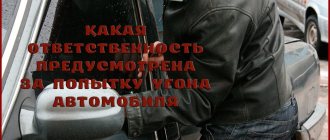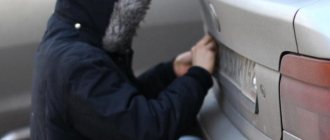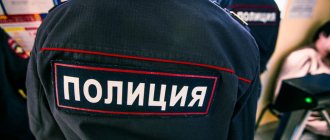ST 166 of the Criminal Code of the Russian Federation.
1. Wrongful seizure of a car or other means of transport without the purpose of theft (theft) - shall be punishable by a fine in the amount of up to one hundred twenty thousand rubles, or in the amount of the wages or other income of the convicted person for a period of up to one year, or by restriction of freedom for a term of up to three years, or forced labor for a term of up to five years, or arrest for a term of up to six months, or imprisonment for a term of up to five years.
2. The same act committed: a) by a group of persons by prior conspiracy; b) has become invalid; c) with the use of violence not dangerous to life or health, or with the threat of using such violence - is punishable by a fine in the amount of up to two hundred thousand rubles or in the amount of the wages or other income of the convicted person for a period of up to eighteen months, or by forced labor for a term of up to five years, or imprisonment for a term of up to seven years.
3. Acts provided for in parts one or two of this article, committed by an organized group or causing particularly large damage, are punishable by imprisonment for up to ten years.
4. Acts provided for in parts one, two or three of this article, committed with the use of violence dangerous to life or health, or with the threat of such violence, are punishable by imprisonment for a term of up to twelve years.
Legislation
Car theft under Article 166 of the Criminal Code of the Russian Federation refers to crimes against property along with theft, fraud, robbery, robbery and other crimes (Chapter 21 of the Criminal Code of the Russian Federation). The corpus delicti under Art. 166 occurs when the following conditions are simultaneously met:
- unlawful conscious possession of a vehicle, that is, without the consent of its legal owner (driver);
- The hijacker’s goal is to drive a vehicle (move the vehicle) without the intention of appropriating it in whole or in parts.
Theft is a complete crime from the moment the vehicle begins to move or moves from the place where it was located (clause 20 of the Resolution of the Plenum of the Supreme Court of the Russian Federation dated December 9, 2008 No. 25).
What is the difference between car theft and theft?
The difference between vehicle theft and theft or other type of theft is that in the first case, the criminal who has taken possession of someone else’s car has no intention of appropriating it, and in the second, his goal is precisely the appropriation (theft) of the vehicle, that is, the unlawful taking of property in for personal gain, for example, for one’s own use or resale to another person.
Therefore, car theft for the purpose of theft will not be qualified under Art. 166 of the Criminal Code of the Russian Federation, and according to another, for example, under Art. 158 (theft), 161 (robbery) or 162 (robbery).
Punishment for car theft
Art. 166 of the Criminal Code of the Russian Federation establishes criminal liability for car theft. In this case, the investigative authorities must not only prove the car theft, but also determine under what circumstances it was committed. The severity of the crime and, accordingly, the punishment for car theft in 2022 depend on this. Courts may limit themselves to a fine, but often give a prison sentence for car theft if there are grounds for it. According to Art. 166 of the Criminal Code of the Russian Federation for car theft in Russia faces:
- for an “ordinary” theft – a fine of up to 120 thousand rubles or in the amount of the convicted person’s income for one year, or restriction of freedom for up to 3 years, or forced labor for up to 5 years, or arrest for up to 6 months, or imprisonment freedom up to 5 years (part 1);
- for theft of a vehicle by a group of persons by prior conspiracy or with the use of violence not dangerous to life or health (with the threat of such violence) - a fine of up to 200 thousand rubles or in the amount of the convicted person’s income for a period of up to 18 months, or forced labor for up to 5 years , or imprisonment for up to 7 years (part 2);
- for acts provided for in parts 1 and 2, committed by an organized group or causing particularly large damage - imprisonment for up to 10 years (part 3);
- for acts provided for in Parts 1, 2 and 3, committed with the use of violence dangerous to life or health (with the threat of such violence) - imprisonment for up to 12 years (Part 4).
We give a decoding of some of the concepts given above, according to the Resolution of the Plenum of the Supreme Court of the Russian Federation dated December 9, 2008 No. 25:
- violence that is not dangerous to life or health is beatings or other violent actions that cause physical pain or restrict the freedom of the victim (for example, tying hands or leaving them in a closed room);
- Violence dangerous to life or health is violence that entailed the infliction of grave and moderate harm to the health of the victim, as well as the infliction of minor harm to health, causing a short-term health disorder or a minor permanent loss of general ability to work;
- especially large damage is assessed based on the actual costs incurred by the vehicle owner for its repair if the car was damaged during theft. The amount of especially large damage is 1 million rubles or more (note 4 of Article 158 of the Criminal Code of the Russian Federation).
Judicial practice under Article 166 of the Criminal Code of the Russian Federation
Resolution of the Presidium of the Supreme Court of the Russian Federation dated March 29, 2017 N 187P16pr
under paragraph “a” of Part 2 of Art. 166 of the Criminal Code of the Russian Federation for 4 years; according to Part 2 of Art. 167 of the Criminal Code of the Russian Federation for 5 years; for aggregation of crimes on the basis of Part 3 of Art. of the Criminal Code of the Russian Federation for 25 years with serving the sentence in a high-security penal colony.
Resolution of the Presidium of the Supreme Court of the Russian Federation dated April 26, 2017 N 48P17
Convicted: under paragraphs “g”, “z”, part 2 of Art. 105 of the Criminal Code of the Russian Federation to 15 years in prison, under paragraph “c” of Part 4 of Art. 162 of the Criminal Code of the Russian Federation to 10 years in prison, under paragraph “a”, part 2 of Art. 166 of the Criminal Code of the Russian Federation to 3 years in prison.
Appeal ruling of the Judicial Collegium for Criminal Cases of the Supreme Court of the Russian Federation dated October 4, 2017 N 72-APU17-21
- part 4 art. 166 of the Criminal Code of the Russian Federation - for 7 years 5 months of imprisonment; - clause “a”, part 4, art. 162 of the Criminal Code of the Russian Federation (in relation to A.) - 9 years in prison with a fine of 250,000 rubles;
Resolution of the Presidium of the Supreme Court of the Russian Federation dated April 11, 2018 N 10-P18
according to Part 4 of Art. 166 of the Criminal Code of the Russian Federation for 8 years; according to paragraphs “g”, “k”, part 2 of Art. 105 of the Criminal Code of the Russian Federation for 15 years; on the basis of Art. Criminal Code of the Russian Federation for aggregation of crimes for 17 years.
Appeal ruling of the Judicial Collegium for Criminal Cases of the Supreme Court of the Russian Federation dated 06/07/2018 N 43-APU18-3
— December 24, 2009, taking into account the changes made, under Part 1 of Art. 166, part 5 art. of the Criminal Code of the Russian Federation to 6 years 6 months of imprisonment; - March 9, 2022 under Part 1 of Art. 158 of the Criminal Code of the Russian Federation to 8 months in prison, the sentence was served on August 27, 2022,
Resolution of the Presidium of the Supreme Court of the Russian Federation dated June 20, 2018 N 63P18
Chernov Denis Grigorievich, ... convicted on November 12, 2013 under clause “a”, part 2 of art. 161, paragraph “a”, part 2, art. 166 of the Criminal Code of the Russian Federation to 2 years of suspended imprisonment with a probationary period of 2 years,
Appeal ruling of the Judicial Collegium for Criminal Cases of the Supreme Court of the Russian Federation dated June 20, 2018 N 64-APU18-2
- under Part 4 of Article 166 of the Criminal Code of the Russian Federation for 8 years; - under paragraph “c” of part 2 of article 158 of the Criminal Code of the Russian Federation for 2 years; - under Part 1 of Article 167 of the Criminal Code of the Russian Federation for 1 year 6 months of imprisonment.
Appeal ruling of the Judicial Collegium for Criminal Cases of the Supreme Court of the Russian Federation dated 07/05/2018 N 14-APU18-12sp
Zotov Sergey Ivanovich, ... convicted on October 21, 2010 under Art. 166 part 2 paragraph “a” of the Criminal Code of the Russian Federation to 1 year 6 months of suspended imprisonment; August 10, 2011 under Art. 158 part 2 paragraph “c” of the Criminal Code of the Russian Federation on the basis of Art. of the Criminal Code of the Russian Federation to 2 years in prison, released on August 9, 2013 after serving the sentence,
Appeal ruling of the Judicial Collegium for Criminal Cases of the Supreme Court of the Russian Federation dated May 15, 2018 N 44-APU18-7
- December 18, 2008 by the Vereshchaginsky District Court of the Perm Territory under clause “a”, part 2 of art. 166, part 1 art. 158 of the Criminal Code of the Russian Federation to 2 years 3 months of imprisonment on the basis of Art. The Criminal Code of the Russian Federation is conditional with a probationary period of 1 year;
Appeal ruling of the Judicial Collegium for Criminal Cases of the Supreme Court of the Russian Federation dated June 28, 2018 N 58-APU18-7sp
SEREDYUK Igor Aleksandrovich, ... convicted on July 24, 2008 under Art. 161 part 1 of the Criminal Code of the Russian Federation to 1 year 5 months of imprisonment; December 22, 2009 under Art. 166 part 2 paragraph “a” of the Criminal Code of the Russian Federation to 2 years of imprisonment; On December 17, 2010, under Article 313 Part 2 of the Criminal Code of the Russian Federation on the basis of Art. of the Criminal Code of the Russian Federation to 5 years 4 months of imprisonment, released on July 24, 2015 after serving the sentence,
Appeal ruling of the Judicial Collegium for Criminal Cases of the Supreme Court of the Russian Federation dated 08/09/2018 N 78-APU18-16
Part 1 Art. 166 of the Criminal Code of the Russian Federation to 2 years of imprisonment, and for the totality of crimes determined according to the rules of Part 3 of Art. of the Criminal Code of the Russian Federation, by partial addition of the imposed penalties - to 15 years of imprisonment to be served in a maximum security correctional colony, with restriction of freedom for a period of 1 year, with the establishment of restrictions: not to change the place of residence without the consent of a specialized government body; not to travel outside the territory of the municipality corresponding to his place of residence after serving a prison sentence, with the imposition of the obligation to appear once a month to register with a specialized state body that supervises the serving of convicts sentences in the form of restriction of freedom.
Attempted car theft
As mentioned above, theft is considered a completed crime from the moment the vehicle begins to move or moves from the place where it was located. If the attacker was unable or did not have time to do this, then this will be regarded as an attempted car theft, that is, an unfinished, but still a crime. For example, if attackers got into a car and tried to steal the car, but were unable to start the engine. An attempt to steal a car, including by minors, will be qualified by the court under Art. 166 of the Criminal Code of the Russian Federation, and the punishment was imposed taking into account the circumstances of the crime.
Additionally
In some cases, theft is carried out to facilitate the implementation of other illegal actions. In this situation, the behavior of the perpetrators is qualified according to the norm in question and the corresponding provisions in the aggregate.
A vehicle that belongs to the accused may be confiscated in accordance with Art. 81 only if it was used as an instrument to commit an intentional crime
In this case, one should take into account the provisions of Art. 264
If the person who committed the crime was found guilty under this rule, the vehicle cannot be considered an instrument of the crime. Some issues of judicial practice related to the proceedings of cases under the commented article are explained by the Plenum of the Supreme Court. In particular, explanations are present in Resolution No. 25 of December 9, 2008.
What to do if your car is stolen
We'll tell you what to do if your car is stolen. It all depends on the specific situation. If you find that someone is trying to steal your car, then in this situation the correct thing to do is:
- do not engage in combat with hijackers in order to avoid causing possible harm to your health, and even more so to your life;
- attract the attention of others by shouting and gestures, throw some object at the car (in such situations, some attackers refuse to attempt theft);
- report the incident to the police, regardless of whether the car was eventually stolen or not.
If the owner (driver) did not find the vehicle in the place where he left it, then first of all you need to understand whether the car is really stolen. To do this, you should call the traffic police department on duty and find out if the car has been towed. If it turns out that the worst happened, and the villains stole the car with documents, then in this case you should report the theft to the police by phone. Then you should go to the nearest police station and report the car stolen.
If the vehicle is insured under CASCO in case of theft, you need to contact the insurance company and notify it of the incident.
The statute of limitations for car theft in Russia depends on the severity of the crime (Articles 15, 78 of the Criminal Code of the Russian Federation), that is, under what part of Art. 166 crimes were classified as follows:
- Part 1 (maximum punishment up to 5 years in prison, crimes of medium gravity) – statute of limitations 6 years;
- Parts 2 and 3 (maximum punishment up to 7 and 10 years of imprisonment, respectively, a serious crime) statute of limitations is 10 years;
- Part 4 (maximum punishment up to 12 years of imprisonment, especially serious crime) – statute of limitations is 15 years.
Where to apply
You need to submit an application to the traffic police. The application should include as much information about the vehicle as possible:
- when and from whom it was purchased, its registration data;
- how much gasoline was left at the time of the theft;
- Have your car documents been lost before?
- what anti-theft systems were installed;
- what marks are on the main units;
- special features (equipment, airbrushing, scratches and other damage, information about things in the car);
- If you have a photo of the car, you must attach it to the application.
After receiving the application, the police officer must issue the applicant a notification ticket, and a criminal case will be initiated based on the application.
It is possible to report a car theft online on the official website of the Ministry of Internal Affairs or its regional subsite. To do this you need:
- On the website of the department (its territorial body), in the “For Citizens” section, select the “Acceptance of applications” item.
- Familiarize yourself with the procedure for filling out and reviewing an application.
- Click on the “Submit Application” button.
- Provide the necessary information, including a description of the circumstances of the incident (recommendations above in this section).
- Attach a file with materials related to the case.
- Enter the antispam code.
- Click on the “Send request” button.
You can also file a report of car theft through State Services. To do this you should:
- Log in to the portal.
- Go to the section “Ministry of Internal Affairs of the Russian Federation”.
- Find a service for receiving electronic appeals (it is not available in every region).
- Fill out and submit a vehicle theft report.
Investigation methodology
The methodological and tactical actions of the investigative authorities depend on the circumstances that take place.
The following stages are distinguished in the investigation process:
- carrying out analytical work regarding the crime situation that has developed in a particular area (they are carried out permanently);
- creation of a unified database on the date and place of attacks;
- checking the effectiveness of accounting at the regional and federal levels.
How effective the investigation process will be depends on the completeness of the data available. Most of this information is obtained by the competent authorities during inspections of the places where the acts were committed.
The investigator most often conducts three types of inspections, in particular, the areas where the car was stolen and where it was found, as well as the object of the attack itself, should be examined.
It is recommended that the actions in question be carried out in the presence of the injured party. This is due to the fact that the victim has the opportunity to accurately indicate the location of his property and report the loss of items from the interior of the car or garage. The external condition of the found car plays a significant role in identifying the culprit. In this case, it is necessary to involve traffic police officers in the inspections, as they may indicate the presence of certain malfunctions. The victim also indicates what changes have occurred to the car during the theft.
You need to reflect the condition of the door locks, speedometer data, and the presence of damage. Information about the fuel level is also displayed, which in some cases will allow you to build a route for the car. When inspecting the area where a car was found, it is necessary to use video or photography.
A significant amount of information is revealed during the interrogation of the victim in the case. He explains what happened before the car was stolen; the day and time of the car’s disappearance are also recorded according to the interviewee. You need to find out from him where the car was located before it was lost, what condition it was in, and reflect in the protocol the individual characteristics of the car, in particular the make and model, year of manufacture, etc. If there was damage to the transport, also indicate in the documents.
An investigation plan is drawn up after the above locations have been inspected and the victim has been questioned. When a missing car is not found, the main efforts are directed towards finding it. For this purpose, information about it is distributed to all traffic police posts.
When a case is initiated due to the arrest of the culprit in a stolen car, a search is included in the urgent actions. It is carried out both at the place of residence of the culprit, and in the garage, at the dacha and other places where evidence could be hidden. Often, persons who have committed illegal attacks leave some small items from the car with them, and later, based on this, the investigation and accusation are built.
To conduct the investigation further, the investigator must understand what type of assault was committed. This could be car theft or theft.
To distinguish between the listed elements, it is necessary to pay attention to the subjective characteristics of the crime. . The interrogation of a suspect is based on the norms contained in the Code of Criminal Procedure
At this time, it is necessary to find out whether the perpetrator committed actions aimed at preparing for the attack. The accused is also questioned after the relevant charges have been filed. The testimony of the perpetrator is verified on the spot, and with its help, circumstances relevant to the case are established. A special action is an investigative experiment, which is carried out in some cases. Various studies are being carried out, on the basis of which the accusation is subsequently built.
The interrogation of the suspect is based on the norms contained in the Code of Criminal Procedure. At this time, it is necessary to find out whether the perpetrator committed actions aimed at preparing for the attack. The accused is also questioned after the relevant charges have been filed. The testimony of the perpetrator is verified on the spot, and with its help, circumstances relevant to the case are established. A special action is an investigative experiment, which is carried out in some cases. Various studies are being carried out, on the basis of which the accusation is subsequently based.
Is there any protection against car theft?
There are several ways to protect your car from theft:
- install an electronic and/or mechanical anti-theft system on the vehicle;
- strengthen the structural elements of the vehicle, for example, apply an armored film to the glass, which will help withstand impacts from a heavy object;
- park in guarded parking lots, in courtyards in a well-lit area and within visibility from the premises, near CCTV cameras;
- make the car noticeable, for example, apply airbrushing to it.
It also makes sense to install a so-called tracker or beacon on the car. This device will not protect your car from theft, but if attackers do not detect the beacon manually or with scanners, it will greatly facilitate the search for a stolen car. In addition, modern trackers and beacons have their own software, thanks to which you can track the movement of a vehicle in real time and even remotely block the engine.
Finally, you can insure your car against theft by taking out a CASCO policy. Of course, this will not help prevent car theft, but the owner of the car will protect himself financially and will receive compensation for damages under CASCO. It should be borne in mind that some insurance companies issue policies only on the condition that security systems are installed on the vehicle. If there is no such system, the insurer may refuse to issue CASCO insurance with the risk of theft or significantly increase the cost of the policy.










